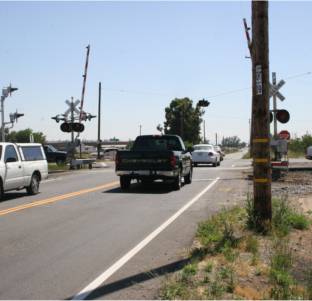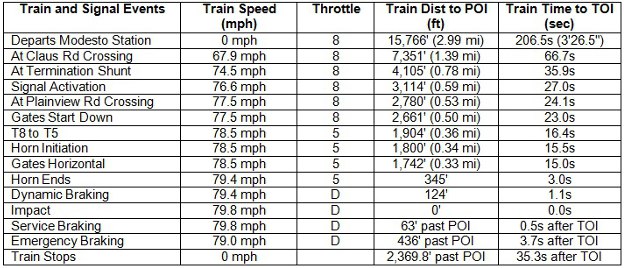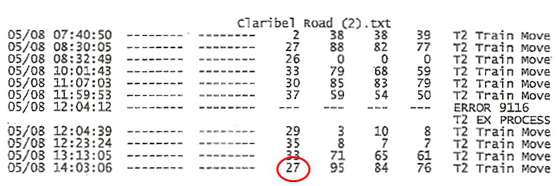Train-Vehicle Collision
at Signalized Grade Crossing
![]()
On May 8, 2007 at 2:05 PM, a northbound Amtrak train collided with an eastbound 2001 Chevrolet Tracker at the Claribel Road highway-rail grade crossing in Stanislaus County, CA. It was daylight, dry, clear, and approximately 92?F at the time of the collision with 10 miles visibility.

Traffic control at the crossing consisted of flashing light signals and gates. About 69 feet east of the crossing was a highway intersection. Traffic control at the intersection consisted of 4-way Stop signs and a 4-way red flashing signal.
The train left a passenger station about three and a half minutes prior to impact and accelerated all the way up until the collision. As the train approached the Claribel Road crossing, the crossing signals activated. The Tracker was on the tracks when the signals activated but was unable to move forward clear of the tracks due to other vehicles between the crossing and the intersection.
The gates came down with the Tracker still on the tracks. The Tracker at one point backed up to the west gate but was still fouling the tracks. When traffic between the crossing and the intersection moved, the Tracker began moving forward but was then hit by the train. Even though the train engineer stated that he saw the vehicle on the crossing when the signals activated, he never applied any air brakes on the train before impact. The train struck the Tracker on its passenger side at approximately 79.8 mph, killing all six occupants in the Tracker.
James Loumiet was retained by the attorneys representing the plaintiffs to reconstruct the collision, evaluate event recorder data from the locomotive and the crossing signals, and analyze braking distances for the train and the ability of Amtrak and its engineer to slow or stop the train prior to impact.
The Amtrak train consisted of an EMD F59PHI locomotive pulling 4 passenger cars. The train was approximately 395 feet long and weighed approximately 430 tons. The locomotive was equipped with 26-C brake control equipment with tread brakes, blended braking features, and wheel slide protection. It's maximum operating speed was 110 mph and it had 8 throttle run positions--notch 1 to notch 8. The locomotive produced 71 psi brake cylinder pressure in independent braking, 60 psi in full service braking, and 91 psi in emergency braking. Each car was also equipped with 26-C brake control equipment and each had eight tread brake units and eight disc brake units.
 The operation of the flashing light signals and automatic gates was controlled by a Safetran GCP 3000D grade crossing predictor. The signal plans showed termination shunts 4,055 feet to the east and to the west of the island circuits on the main line track. The shunts defined the approach circuits to the crossing. The island circuit extended 50 feet minimum from the edges of the crossing surface.
The operation of the flashing light signals and automatic gates was controlled by a Safetran GCP 3000D grade crossing predictor. The signal plans showed termination shunts 4,055 feet to the east and to the west of the island circuits on the main line track. The shunts defined the approach circuits to the crossing. The island circuit extended 50 feet minimum from the edges of the crossing surface.
The signal plans indicated the signals had a design warning time of 35 seconds and was designed for a maximum train speed of 79 mph on the main line track. However, the GCP 3000D takes nominally 4 seconds from when a train reaches a termination shunt to calculate its speed and predict its arrival time to the crossing so that the actual design warning time was nominally 31 seconds.
Both the locomotive event recorder and the signal system event recorder were downloaded after the collision. By integrating the data from these two recorders, Mr. Loumiet was able to reconstruct the operation of the train and the signals leading up to and after the collision. A summary of the train and signal operations are shown in the table below.

The GCP 3000D download (shown below) indicated that the flashing light signals activated 27 seconds prior to the train reaching the crossing so that they activated 8.9 seconds after the front of the train reached the termination shunt, with the front of the train 3,113.6 feet south of the point of impact traveling at 76.6 mph in throttle notch 8.

The automatic gates started their downward motion approximately 4 seconds after the signals were activated, which was 23 seconds prior to impact, with the front of the train 2,660.6 feet south of the point of impact traveling at 77.5 mph in throttle notch 8.
The gates reached their horizontal position approximately 8 seconds after they began descending, which was about 15 seconds prior to impact, with the front of the train 1,742.2 feet south of the point of impact traveling at 78.5 mph in throttle notch 5.
The engineer initiated the locomotive horn 15.5 seconds prior to impact and stopped sounding the horn 3 seconds prior to impact. The event recorder showed a continuous operation of the horn during this time. This continuous operation of the horn was different than the horn operation shown for previous crossings, where the horn was operated in an on-off pattern.
A service brake application was made by the engineer 0.5 second after impact, when the front of the train was 63.2 feet north of the point of impact. The train was traveling at 79.8 mph when the service brakes were applied. He then made an emergency brake application 3.7 seconds after impact when the front of the train was 435.7 feet past the point of impact. The was traveling at 79.0 mph when the emergency brakes were applied. The train came to a stop with the front of the train 2,369.8 feet north of the point of impact.
Mr. Loumiet also calculated various collision avoidance scenarios where the train could have either been stopped prior to reaching the crossing, or its arrival to the crossing could have been slowed so that the Tracker had more time to clear the tracks.
Mr. Loumiet determined that if the locomotive throttle had been placed in idle when the signals first activated so that the train coasted rather than continued to accelerate, the train would have slowed from 76.6 mph at signal activation to 73.1 mph by the time it reached the Claribel Road crossing. As a result, it would have taken the train an additional 1.4 seconds to reach the crossing, giving the Tracker that much additional time to clear the crossing.
If the train speed had been uniformly reduced starting when the signals first activated so that it was traveling at 70 mph when it reached the Claribel Road crossing, it would have taken the train an additional 2.0 seconds to reach the crossing, giving the Tracker that much additional time to clear the crossing.
If the train brakes had been applied in full service braking when the signals activated, the train would have braked to a stop in 2,507 feet so that the front of the train would have stopped 606.6 feet before reaching the Tracker. If the train brakes had been applied in emergency braking when the signals activated, the train would have braked to a stop in 1,965 feet so that the front of the train would have stopped 1,148.6 feet before reaching the Tracker.
If the train brakes been applied in emergency braking when the locomotive horn was initially sounded for the Claribel Road crossing, the train would have been traveling at approximately 30 mph when it reached the crossing. As a result, the train would have taken an additional 7.1 seconds to reach the crossing, giving the Tracker that much additional time to get clear of the crossing and avoid impact.
![]()
